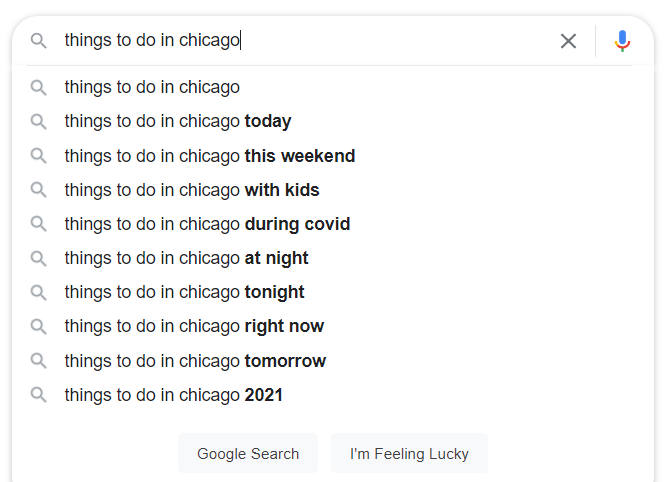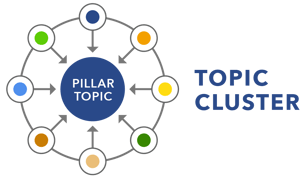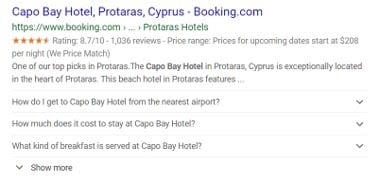SEO Content Writing:
How to Write SEO Content That Performs


In today's digital landscape, the phrase "if you build it, they will come" no longer applies. Simply creating content isn’t enough—visibility is everything.
SEO content plays a crucial role in ensuring your brand appears where your audience is searching. But what exactly is SEO content, and how can you use it to drive organic traffic and outperform competitors?
In this comprehensive guide, we’ll break down the key elements of SEO content and share proven strategies to help you create high-impact pieces that rank, engage, and convert.

SEO content refers to any form of written or visual content that is created to earn search visibility on the SERPs. It prioritizes the experience of organic visitors by offering useful information that matches the intent of the searchers' queries.
Because Google shows various types of content on its SERPs (depending on the underlying intent of the query), SEO content can include.
SEO content isn't just adding keywords to a page and with hopes that the page ranks well. This was how search used to operate, but Google has evolved over the years.
Now, everything is dependent on providing value and a positive search experience. Essentially, Google's approach has changed, and digital marketers' approach has to change, too.
SEO content today has to address the correct user intent, in the right format, for the right target audience.
SEO content helps users find your site—even when they aren’t searching for it specifically. By aligning with user intent, it puts your brand in front of potential customers at key moments in their buying journey.
This is the power of SEO: it drives organic traffic by making your brand visible when and where it matters most. It’s a core part of inbound marketing, allowing customers to discover your business naturally and build trust on their own terms.
Well-optimized content not only improves your search rankings but can also push competitors further down the SERPs—especially for high-volume, relevant topics directly tied to your business.

“Content is the bedrock of practically all SEO efforts … It's what drives traffic, pushes the sale to close, and leaves the reader interested in what you have to say ..."
There are multiple steps that come together to form expert, authoritative, trustworthy SEO content.
Each of the sections below will include hyperlinks to further readings and resources so you can master the process of SEO content creation.
All content marketing efforts begin with thorough keyword research. This step is crucial to ensuring your content aligns with user demand and has the potential to rank.
Recommended Reading: The Ultimate Guide to Keyword Research
Keyword research helps you understand how your audience searches for information and, more importantly, whether they’re searching for it at all. You don’t want to create content around a topic with no search demand—that’s wasted time and effort!
A simple (but time-consuming) way to explore keywords is using Google’s autofill to see popular search queries.

However, this method lacks efficiency and scalability. Instead, we recommend using a keyword research tool or an SEO platform to streamline the process.
Keyword research isn’t just about search volume—it’s also about search intent. There are four main types of intent:
The intent behind a keyword determines the best type of content to create.
For example:
A proper keyword research tool will reveal the intent(s) for the keyword that you input.
For example, in seoClarity's Research Grid, the query "what to do in Chicago" shows informational intent, meaning a listicle or blog post would be ideal. The SERP also includes video results, suggesting that embedding a video could enhance the content’s performance.
 (This query demonstrates an informational intent.)
(This query demonstrates an informational intent.)
Try it out for yourself! Access our to get started with keyword research.
to get started with keyword research.
If you don’t have access to a keyword research tool to automatically reveal intent, you can review top ranking content to locate patterns. This clues you in on what Google considers best practice/the best content for your topic of interest.
Remember that Google understands queries and content beyond the individual keywords used — it understands the semantic content and meaning of the page as a whole. This means you need to include semantic variations of your target keyword throughout your content.
What exactly do we mean by this? Let's stick with our "what to do in chicago" example from above.
In the old days of SEO, a writer would be concerned with putting that exact phrase ("what to do in chicago") in as many places as possible on the page. It may have looked something like this:
Are you wondering what to do in Chicago? If you come to the Windy City, you may wonder what to do in Chicago. Luckily, there are many things that you can do in Chicago to make the most of your time. Here is a list of what to do in Chicago.
Do you see the problem with that?
It sounds mechanical and offers no value to the end user reading this. The content is more concerned with cheating the algorithm in an attempt to rank well than it is with providing a positive end-user experience.
Today, content needs to address the entirety of the topic, and that's where artificial intelligence and machine learning technology come into the content creation process.
When we enter the query into Content Fusion, our AI content optimization feature, we see a list of 20 must-use topics to cover in the content.

(Content Fusion must-use topics for a query.)
Now, we know what to include in the content that will demonstrate our overall understanding of the topic.
If this content piece was hired out to a writer based in New York, they may not have known about the Lincoln Park neighborhood or Grant Park.
This serves a variety of purposes:
 to see how it elevates the quality of your content coverage, or check out our list of the best content analysis tools.
to see how it elevates the quality of your content coverage, or check out our list of the best content analysis tools.
A well-structured content brief is essential for producing authoritative, well-optimized content. It ensures all key topic areas are covered and helps maintain consistency and quality.
If you're working with a content writer, a detailed brief also eliminates miscommunication, reduces revisions, and streamlines the writing process.
To set your content up for success, include these essential elements:
Want to see how a content brief can streamline your content projects? Let us send you a free, AI-generated content brief to get you started!
A well-structured content brief should also outline internal linking opportunities to reinforce your site’s authority and improve search visibility. An effective internal linking strategy connects related content, helping both users and search engines navigate your site more efficiently.
At the core of this strategy are topic clusters—groups of interlinked content that comprehensively cover a subject.

Each piece within the cluster addresses a different angle, with a central pillar page serving as the authoritative hub.
This approach signals to Google that your site provides comprehensive, in-depth coverage on a topic, strengthening your expertise and increasing the likelihood of ranking for high-value keywords.
By including internal linking recommendations in your content brief, you ensure that every piece of content:
With all these elements clearly outlined, your content team will have a precise roadmap to follow—ensuring each piece serves a strategic purpose.
Google prioritizes content that is valuable, original, and user-focused, so your writing must go beyond basic keyword inclusion—it should provide real insights, answer user queries, and establish authority in your industry.
To create content that will perform well in the SERPs, follow Google's Search Quality Rater Guidelines known as E-E-A-T.
In addition to ranking better in Google because it provides real value and reliable information, high E-E-A-T content also reduces bounce rates and increases conversions by improving user trust and engagement.
Today’s users expect more than just well-written content—they want a dynamic, interactive experience. With Google’s SERP features like Answer Boxes, Images, and People Also Ask, searchers are used to content that is quickly digestible and visually appealing.
If your page lacks engaging elements, users are more likely to bounce back to the SERP—and straight to a competitor. That’s a missed opportunity.
So, how do you create engaging content? Here are a few ideas:
Recommended Reading: SEO Content Writing Tips
Google uses hundreds of ranking factors to determine which content will appear in the search results, so writing the content isn’t the end of the journey!
You've targeted a search term with demand, created a detailed brief, and written the SEO content. Now, it's time to optimize the content before its publication. Here are some effective ways to do so...
Title tags and meta descriptions are short snippets of information that explain what your page is about. If they are written well, they can appear directly on the SERPs with your search listing.

Note: Each organic SERP listing will always have a title and meta snippet present, they just may not be the ones you wrote...
If your title tag or meta description doesn't include your target keyword (or provide any value to searchers), Google may rewrite your title for you.
Even though Google thinks beyond individual keywords, doing this will make it clear for users what your page is about.
Resources on Metadata:
Images can include loads of relevant information, the only trouble is that search engines can't read them. This means that despite you having great content for the users, search engine bots will be none the wiser.
To overcome this, simply include an alt tag for the images on your site. Alt text is a brief description of an image that users don't see, but search engines do.
Nothing too detrimental will happen if you don't include alt text, but it is a missed optimization opportunity if you don't include it.
A call to action (CTA) pushes your readers to do something. Whether it be subscribing to an email newsletter, downloading an ebook, or demoing a product, a CTA is your chance to have the readers take the next step. They've read your content — now what?
Sure, traffic is a nice metric to pay attention to, but that's only the beginning. What was this content trying to solve?
If users come to your site, read the content, and leave, you've hardly pushed anyone toward a conversion. Remember that SEO content is meant to earn search visibility, provide value, generate leads, and score conversions.
Once your content is written, you can take it a step further with schema markup. Whether adding it to new pages or refreshing existing content, schema helps search engines better understand your content and can unlock rich results in the SERPs.
Schema (also called structured data) is a snippet of code added to a webpage that provides extra context to search engines about the page’s content. While not mandatory, it enhances visibility and improves user experience in search results.
For example, here’s the difference between a standard SERP listing and one enhanced with schema:


No Schema FAQ and Star Schema
You can see the first SERP listing is pretty standard: the title tag, URL, and meta description. The second picture is where we really get an idea of what schema can do. The FAQ schema increases search visibility of the search listing (more pixel space) and offers immediate value to users, while the star schema offers social proof.
There are hundreds of schema types and properties to choose from at schema.org. Ultimately, this simple code addition can make your listing more eye-catching, informative, and click-worthy.
No developer? No problem. Free tools like Schema Builder let you easily create, test, and deploy schema markup without coding expertise.
Congratulations—your SEO content is written and published! 🎉
Now, it’s time to get it in front of the right audience. While organic search will drive traffic over time, a content distribution strategy helps amplify its reach faster.
To reach new audiences on external sites, consider SEO content syndication, which republishes your content on third-party platforms to maximize visibility. Just like distribution, there are:
If you’re concerned about duplicate content, use canonical tags or attribution links to indicate the original source. This ensures SEO integrity while still expanding your content’s reach.
By combining organic search, strategic distribution, and smart syndication, your content works across multiple channels to drive traffic, engagement, and conversions.
The last step of SEO content writing is to track and report on the content's performance. After you publish, it’s crucial to monitor, track, and analyze your SEO metrics.
Different organizations care about different SEO key performance indicators (KPIs) since each organization has different business goals to work toward.
Some may care about traffic, bounce rate, or time on page, while others may care about rank, and conversions.

(Page metrics for a blog post.)
Not sure what your KPI is? Ask yourself why you created the content. What was your end goal for this specific content piece?
Two great tools to monitor search performance are Google Analytics and Search Console. Both are free to use, and are goldmines for discovering various insights into your content and audience.
There are a lot of other free SEO tools out there, too. Some help with keyword research, others are great for content marketing. We put together a list of the top free SEO tools you can use.
If you use an SEO platform, it should offer the ability to integrate your analytics data so you can see all of your performance data in one centralized location.
If you decide that it’s time to hire someone for SEO, specifically in the realm of content, that person should have an understanding of:
Another option is to outsource the content. This involves having an outside party complete the entire checklist: from conducting the background research to writing and optimizing the content.
This method can help guarantee that an SEO expert is crafting the content with all best practices in mind.
seoClarity's Content Writing Services, for example, creates authoritative, optimized content that performs for clients in various verticals. The members of our Professional Services team leverage our SEO platform to create data-backed content that delivers on your KPIs.

There you have it! A complete look at how to write SEO content. From the evolution of Google that changed how we consume (and create) content, to the step-by-step approach to demonstrating your authority — you now know how to create content.
Along your content creation journey, you'll discover that there are a number of tools that can help to simplify the process. We'd like to point you in the direction of the Spark Content Optimizer — our free Google Chrome plug-in that allows anyone on a team to create an all around better search experience for their users.
Good luck on creating your SEO content!